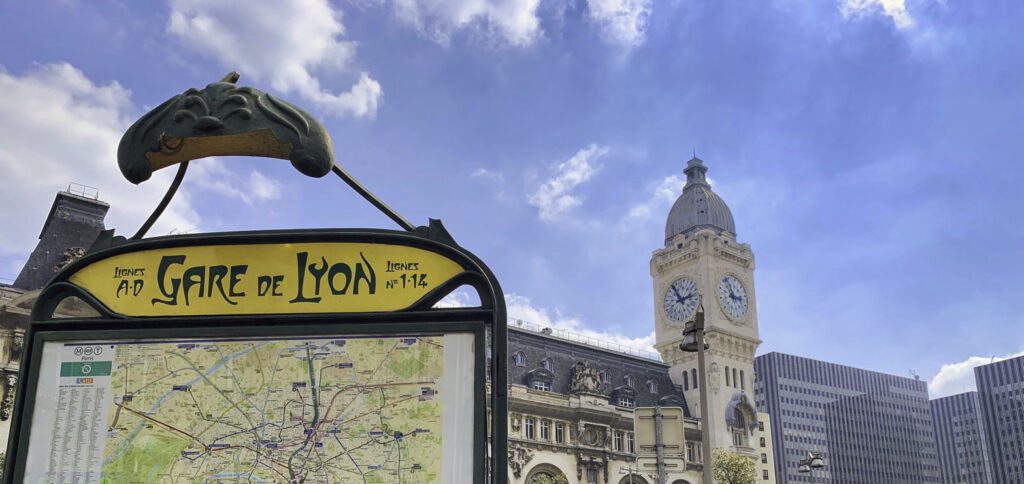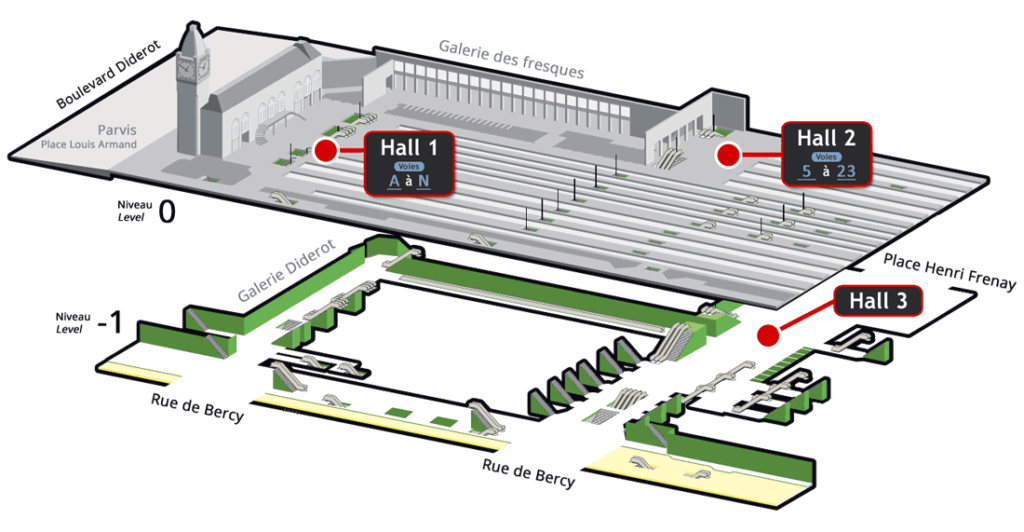Best service in town
HOW TO BOOK A TAXI FROM AND TO PARIS GARE DE LYON ?
Reservations to and from Gare de Lyon can be made by :
- Via the website using the booking module above.
- Through Whatsapp by clicking on the green contact button above.
- By phone.
- By email at : “contact@en.allo-taxi-paris.net”.
Before booking, make sure to :
- Enter your phone number in international format if it’s not french (exemple : +34 for Spain)
- Enter the exact number of luggage you will carry with you to make sure that you’ll get the right vehicule for your needs.
- Enter your train number as well as where it is coming from.
- Make sure you gave the right email address and phone number
You will receive an email or an SMS as confirmation that your ride is booked with all the order information as well as the numbers to call if needs be.
PICK-UP AT PARIS-GARE DE LYON :
Pick-up takes place at the foot of the big clock, as shown in the photo below.
Step 1 : go to Hall 1.
Step 2 : go to the J & K lane.
Step 3 : exit with your back to the train straight ahead.
There you are.
The driver will contact you 15 minutes before your train arrives at the station to remind you of the pick-up details.
At the client’s request or if the drop-off point is full, the meeting point can be changed in which case you will be notified.
If needed, don’t hesitate to call him so he can come find you himself.
(This is also the drop-off point)
FARES AND PAYMENTS :
Rate estimates can be obtained directly online via the link above.
You don’t need a credit card to book online (you can pre-pay for the journey if you wish).
Payment is made to the driver at the end of the journey, by CREDIT CARD or CASH. (checks refused).
An invoice will be sent to you on request.
BOOKING FOR SOMEONE ELSE AT GARE DE LYON :
You can make a reservation for someone else as long as you specify the mobile phone number of the person travelling first, then that of the person ordering, so that they can be kept informed if necessary.
If you wish, you can pay in advance by credit card using our online module, or via a secure payment link sent to you by text message.
REQUEST FOR MULTIPLE JOURNEYS OR EVENTS :
Please contact us by phone on the number above.
You can also contact us at : “contact@en.allo-taxi-paris.net“
TRAIN TIMETABLES AND DELAYS :
In the event of a delay, we can use your train number to track you live and rebook you free of charge:
PLAN AND DIRECTIONS :
The station is divided into three parts: Halls 1 and 2, which are above ground and receive trains, and Hall 3, which is on level -1.
Hall 1 has train tracks from A to N, while Hall 2 has tracks from 5 to 23.
Hall 3 crosses the station from the rue de Bercy to the place Henri Frenay, and offers easy access to all the platforms thanks to the escalators and staircases.
At your service 24/7

Payment by credit card in all our vehicles.

An invoice at the end of your journey.
A choice of vehicles adapted to your needs:

Economy
• 4 Passengers (max)
• 2-3 luggage depending on size
• Cheapest price

Comfort
• 4 Passengers (max)
• 5-8 luggage depending on size
• Onboard credit card terminal with invoice
• Waiting for up to an hour and a half
• Best drivers

VAN
• 7 Passengers (max)
•7-15 luggage depending on size
• Onboard credit card terminal with invoice
•Wi-fi onboard
• Waiting for up to an hour and a half
• Recent VAN

HISTORY OF PARIS - GARE DE LYON
Gare de Paris-Lyon is one of the most important stations in the Paris region. It was built in the middle of the 19th century to serve the railway line between Paris and Lyon, which was then the busiest in France. It is located at Place Louis Armand in the 12th arrondissement of Paris.
Today’s Gare de Lyon was built in 1899 in the academic style of 1900 and features a 64 m-high belfry with 4 dials measuring 6 m in diameter. Built for the 1900 Universal Exhibition, the new station was designed by architect Marius Toudoire to replace the old station built in the mid-19th century, which was located on a median strip to protect it from flooding by the Seine. While a spectacular 64m-high clock tower dominates the building, the main façade is punctuated by large semi-circular arches. Paul Garnier created a monumental clock (6.40m in diameter) on all four sides. The tower is worthy of a theatre set, with windows and balconies that are inaccessible from the inside. It is covered by a dome that was once gilded and embellished with statues.
Originally with four tracks and two platforms, but expanded over the years to meet the growing needs of passengers, Paris-Lyon station underwent a period of modernisation and renovation in the early 20th century.
Equipped with new communication technologies such as the telegraph and telephone, which facilitated communication between trains and station controllers, it was also enhanced with shops, restaurants and comfortable waiting rooms.
During Europe’s belligerent period in the First World War, Paris-Lyon station was also used as a triage centre for the war-wounded, who were transported to hospitals in the region, and played an important role in the transport of troops and war material.
PARIS - GARE DE LYON TODAY :
Over the following decades, Paris-Lyon station continued to evolve and adapt to the growing needs of passengers. It has been served by numerous train lines, including TGV high-speed trains and RER commuter trains. The station is also linked to a number of public transport services, such as buses, which provide easy access to other destinations in the region.
Today, Paris-Lyon station is one of the busiest in France, receiving millions of passengers every day. It has many modern facilities, such as automatic ticket machines, ticket purchase terminals and interactive information panels. The station is also accessible to people with reduced mobility, thanks to lifts and escalators.
In addition to its role as a transport hub, Paris-Lyon station has also become a place of life and entertainment, with numerous shops, restaurants and other businesses. It is an essential stop-off point for travellers and local residents alike.
In short, the history of Paris-Lyon station is closely linked to that of the city of Paris and the surrounding area. It has played an important role in passenger and freight transport over the years, and has adapted to the changes and growing needs of its users. Today, Paris-Lyon station remains one of the most important stations in France and continues to play a crucial role in passenger transport in the region.
CHALLENGES FOR PARIS - GARE DE LYON IN THE COMING YEARS AND THE ARRIVAL OF THE OLYMPIC GAMES :
Paris-Lyon station is one of the most important stations in France and will play a crucial role during the 2024 Olympic Games, which will be held in Paris. However, it faces a number of challenges in the years ahead, particularly in terms of capacity and modernisation.
One of the main concerns for Paris-Lyon station is its ability to accommodate large numbers of passengers during the Olympic Games. The station already handles millions of passengers every day and will need to be able to cope with an additional influx of visitors and athletes during the Games period. This will require effective planning and coordination to ensure that passengers can travel safely and without disruption.
Paris-Lyon station also needs to modernise and upgrade its facilities and equipment. The station already has many modern facilities, but it needs to be able to meet the growing demands of passengers in terms of comfort and services. This could include improvements to accessibility for people with reduced mobility, as well as the addition of new technologies to improve travel efficiency and convenience.
Finally, Paris-Lyon station must also take into account the growing competition from other means of transport, such as VTCs (chauffeur-driven cars) and car-sharing services. To remain competitive and attract passengers, the station must be able to offer quality services and competitive fares.
To sum up, Paris-Lyon station faces a number of challenges in the years ahead, particularly in terms of capacity and modernisation. It must be able to meet the growing needs of passengers and compete with other means of transport. By adapting and offering quality services, Paris-Lyon station can continue to play an important role in travel transport.
Available anywhere, for you.



